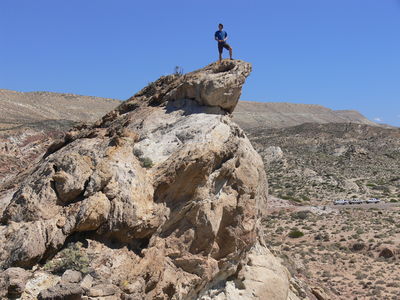Who finds oil?
| Exploring for Oil and Gas Traps | |

| |
| Series | Treatise in Petroleum Geology |
|---|---|
| Chapter | Developing a philosophy of exploration |
| Author | Edward A. Beaumont, Norman H. Foster, Richard R. Vincelette, Marlan W. Downey, James D. Robertson |
| Link | Web page |
| Store | AAPG Store |

Only a small percentage of people exploring for oil, gas, and other natural resources actually find those resources in commercial quantities. We fervently believe, however, that one learns to be an oil and gas finder. Two of the best ways to learn to become oil finders are (1) to familiarize ourselves with the successful approaches and techniques of other oil and gas finders and (2) to develop our visual thinking skills.
Academic training[edit]
Theoretically, every geologist with a master's degree or higher from an accredited institution has the necessary scientific background to be a successful explorationist. Thorough training in structural geology, stratigraphy, sedimentology, geomorphology, paleontology, remote sensing, mineralogy, petrology, volcanism, economic geology, geophysics, and geochemistry are fundamental. A course in petroleum engineering is very helpful. Also, a rigorous field geology course is absolutely essential because one must learn to observe and record information accurately in the field, thinking in the third and fourth dimensions and developing a sense of the size of geological features.
Impact of technology[edit]
A few years of experience in the industry should prepare an individual to use the latest technology. Computers process data rapidly, which was impossible just a short time ago. This has allowed us, for example, to develop 3-D and 4-D seismic data gathering and processing. In addition, computers allow us to compare thousands of data sets rapidly, as in surface geochemical ratios. But even with all the new technology, thorough scientific training, and new scientific and engineering understanding, only a small percentage of people searching for oil, gas, and minerals ever find them in commercial quantities.
Teams[edit]
To overcome the huge amount of technological know-how needed for successful exploration, most companies form multidisciplinary teams. The synergies achieved by several individuals with different specialized skills working to solve a problem can be a successful approach. However, the creative spark of one or more members of the team to correctly interpret the geology (with the aid of scientific understanding and technology) is the essential element for success.
Creativity[edit]
Given that most geologists and geophysicists are scientifically and technically competent, what is it that separates the oil and gas finders from the crowd? Creativity is the most important ingredient in exploration, and creativity is enhanced through visual thinking. We define creativity as the ability to look at the same data that everyone else has but to see something different. It involves looking at data from many different perspectives—thinking outside “the box,” yet always honoring known facts to make an interpretation that varies from the beaten path. One must constantly attempt to see what might be there, instead of discounting what may not be known to us.
Visual training[edit]
Geology is a visual science. To make insightful observations and dream more imaginative concepts, the visual skills of the geologist must be developed fully.
In the past, some geology or earth science departments required a basic course in drawing for a baccalaureate degree. The ability to draw freehand and illustrate various geological phenomena was deemed indispensable. Many geologists became quite proficient in sketching thin sections, fossils, outcrops, and other geological features. But beginning in the 1930s, the drawing requirement was dropped. With the development of the camera and the ease and economy of its use came the belief that drawing proficiency was no longer necessary. All one needed was to snap the camera with the proper exposure and focus, and an even more accurate record (more accurate than drawing the feature oneself) could be obtained.
Today, of course, there is the choice of black-and-white or living color. Earth scientists have retained some of the knowledge of how to diagram and draw by making maps, cross sections, and block diagrams. Unfortunately, by not learning to draw at an adult level, we have largely given up one of our most powerful tools of learning: to think visually and to observe critically. These are the keys to creative thinking, problem-solving, and developing new concepts.